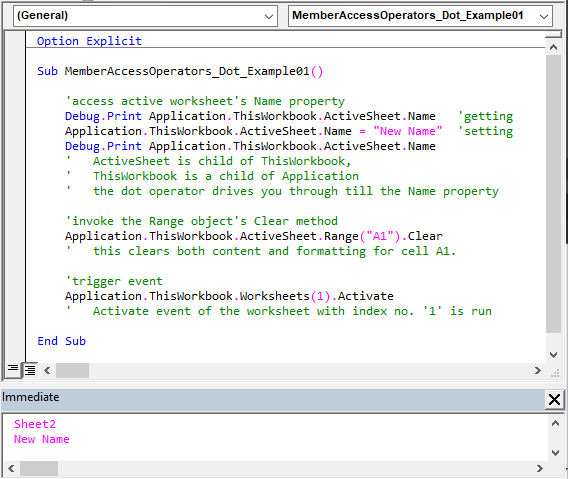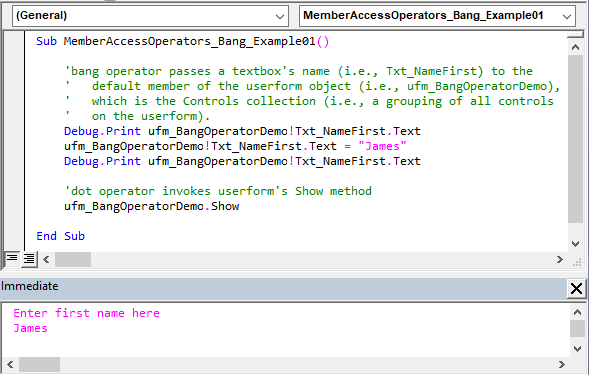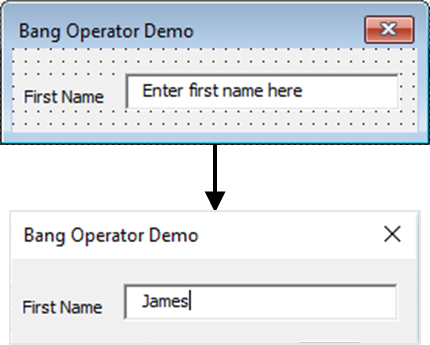VBA Operators
VBA operators are special tokens that instruct the compiler to “operate” on values or program identifiers. They are also referred to as program symbols or code elements. Also, the program identifiers they operate on (e.g., addition) must be capable of holding values.
You may have heard of the term operand. These are the values (i.e., literals) or identifiers (e.g., variables and constants) that operators act on. Based on their number of operands, operators are either unary or binary.
Unary VBA operators are operators that only act on a single operand at a time. Binary VBA operators are those that only act on two operands at a time.
VBA supports the following categories of operators:
- Assignment Operator;
- Member Access Operators;
- Concatenation Operators;
- Arithmetic Operators;
- Comparison Operators;
- Logical Operators.
This article takes an in-depth look at the VBA member access operators.
VBA Operator Precedence
Often, an operation involves more than one operator, sometimes of different categories. So, it is worthwhile paying special attention to the order of precedence of the VBA operators. Otherwise, VBA’s default operator precedence applies.
The default precedence is as follows: arithmetic first, then concatenation, followed by comparison, then logical, and finally assignment operators.
Moreover, there is a pre-set precedence for operators within each category. How do you override this default order and remove any ambiguity? Easy, set the preferred precedence with open and close parentheses, ( ).
Member Access Operators
Member access operators ease the referencing (i.e., accessing) of class or object’s members (i.e., properties, methods, or events). There are two such VBA operators, the dot (.) and bang or exclamation point (!) operators, as described in the table below.
| Operator | Description | Outcome | Precedence |
|---|---|---|---|
| . | Dot (binary) operator grants access (read/write) to a class, object, or enumeration’s properties, methods, and events. It also allows access to a class or object’s child classes or objects, serving as the only way to traverse the VBA object hierarchy. | Gets or sets a Property-value; Calls or invokes a Method; Triggers an Event. | 1 |
| ! | Bang (binary) operator grants write-only access to a class or object’s default property – whose value must be a String. | Sets the default Property-value to a String | 1 |
As shown in the table, both member access operators have the same precedence. So, when they both appear together in an expression, evaluation proceeds in the order of appearance from left to right.
Besides, enclosing a part of an expression in parentheses prioritizes its evaluation ahead of other parts.
For both the dot and bang operators the class, object, or enumeration (1st operand) must be separated from the member being accessed (2nd operand) by the operator, with no space in-between.
Member Access Operators: Dot (.)
The sample code below shows the dot (.) operator’s usage in accessing class or object members.
|
1 2 3 4 5 6 7 8 9 10 11 12 13 14 15 16 17 18 19 20 21 |
Option Explicit Sub MemberAccessOperators_Dot_Example01() 'access active worksheet's Name property Debug.Print Application.ThisWorkbook.ActiveSheet.Name 'getting Application.ThisWorkbook.ActiveSheet.Name = "New Name" 'setting Debug.Print Application.ThisWorkbook.ActiveSheet.Name ' ActiveSheet is a child of ThisWorkbook, ' ThisWorkbook is a child of Application ' the dot operator drives you through till the Name property 'invoke the Range object's Clear method Application.ThisWorkbook.ActiveSheet.Range("A1").Clear ' this clears both content and formatting for cell A1. 'trigger event Application.ThisWorkbook.Worksheets(1).Activate ' Activate event of the worksheet with index no. '1' is run End Sub |

Member Access Operators: Bang (!)
While the dot operator allows retrieving and setting any property’s value, the bang operator only allows setting a single String as the value of only the default property. The sample code below demonstrates the bang operator’s usage.
|
1 2 3 4 5 6 7 8 9 10 11 12 13 14 15 16 |
Option Explicit Sub MemberAccessOperators_Bang_Example01() 'bang operator passes a textbox's name (i.e., Txt_NameFirst) to the ' default member of the userform object (i.e., ufm_BangOperatorDemo), ' which is the Controls collection (i.e., a grouping of all controls ' on the userform). Debug.Print ufm_BangOperatorDemo!Txt_NameFirst.Text ufm_BangOperatorDemo!Txt_NameFirst.Text = "James" Debug.Print ufm_BangOperatorDemo!Txt_NameFirst.Text 'dot operator invokes userform's Show method ufm_BangOperatorDemo.Show End Sub |


Lastly, for the bang operator, the 2nd operand cannot be a String literal (i.e., a series of characters enclosed in double-quotes) or String variable. Only valid Visual Basic identifiers are allowed, e.g. object name as in the sample code above.


![The While – Wend statement’s syntax. Square brackets, [ ], indicate optional items.](https://masterofficevba.com/wp-content/uploads/2021/03/While_Wend_Statement_Syntaxnew.png)
![The Do – Loop Until statement’s syntax. Square brackets, [ ], indicate optional items while vertical bars, |, indicate mutually exclusive items.](https://masterofficevba.com/wp-content/uploads/2021/03/Do_Loop_Until_Statement_Syntaxnew.png)
![The Do – Loop While statement’s syntax. Square brackets, [ ], indicate optional items while vertical bars, |, indicate mutually exclusive items.](https://masterofficevba.com/wp-content/uploads/2021/03/Do_Loop_While_Statement_Syntaxnew.png)
![The Do Until – Loop statement’s syntax. Square brackets, [ ], indicate optional items.](https://masterofficevba.com/wp-content/uploads/2021/03/Do_Until_Loop_Statement_Syntaxnew.png)






![The While – Wend statement’s syntax. Square brackets, [ ], indicate optional items.](https://masterofficevba.com/wp-content/uploads/2021/03/While_Wend_Statement_Syntaxnew-300x163.png)
![The Do – Loop Until statement’s syntax. Square brackets, [ ], indicate optional items while vertical bars, |, indicate mutually exclusive items.](https://masterofficevba.com/wp-content/uploads/2021/03/Do_Loop_Until_Statement_Syntaxnew-300x163.png)